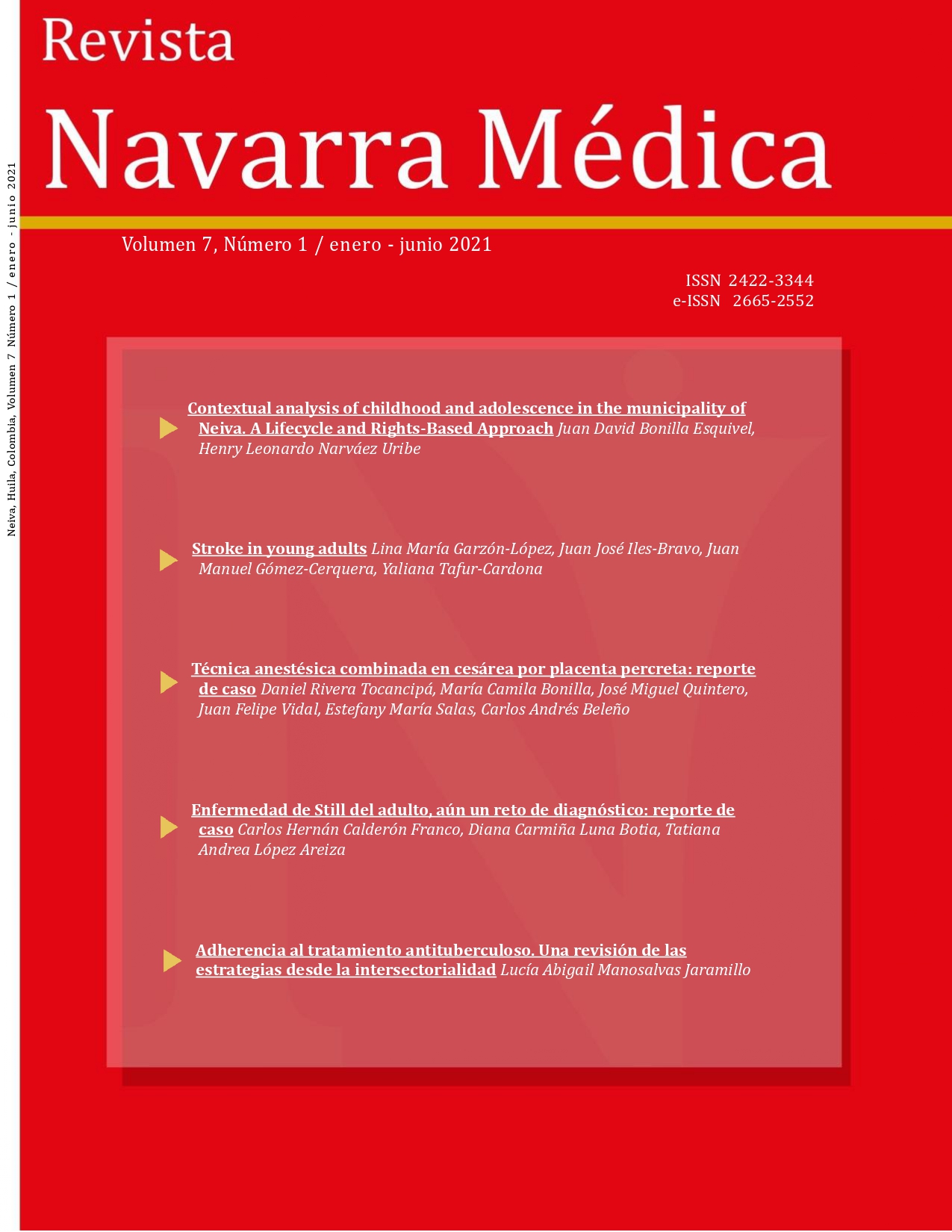Infarto cerebral en adultos jóvenes
DOI:
https://doi.org/10.61182/rnavmed.v7n1a2Palabras clave:
Accidente Cerebrovascular, Etiología, Adulto Joven, Factores de riesgoResumen
Antecedentes El accidente cerebrovascular (ACV) representa la segunda causa de muerte e incapacidad en el mundo. Es menos prevalente en menores de 50 años, pero genera un importante impacto en la sociedad y el sistema de salud. El sistema de clasificación etiológica del Trial of Org in Acute Stroke Treatment (TOAST) incluye 5 categorías: aterotrombótico, cardioembólico, lacunar, debido a causas poco frecuentes (inhabitual) y de origen indeterminado. El abanico etiológico del ACV isquémico en menores de 50 años es más heterogéneo respecto a pacientes de mayor edad.
Objetivo Establecer la etiología más frecuente del ACV isquémico en menores de 50 años en las clínicas Mediláser S.A de Tunja y Neiva entre 2013 y 2017.
Metodología Estudio descriptivo, observacional, retrospectivo de corte transversal. Se revisó el historial clínico de pacientes menores de 50 años con diagnóstico de ACV isquémico confirmado por neuroimagen (Tomografía Computarizada – TC o Resonancia Nuclear Magnética – RNM) en las clínicas mencionadas entre los años 2013 y 2017. Se determinó la etiología de ACV isquémico según la clasificación del TOAST.
Resultados Se encontraron 69 pacientes. La media de edad fue de 39 años (DS: 2). Relación hombre/mujer de 1,3/0,7. Respecto a la etiología, 22 % fueron relacionados con origen cardioembólico, 7 % aterotrombótico, 4 % de pequeño vaso, 6 % inhabitual y 30 % indeterminado. La tasa de mortalidad general fue del 13 %. En el 70 % de los casos, el área cerebral más afectada fue la arteria cerebral media. La hipertensión arterial fue el factor de riesgo más frecuentemente asociado al ACV, presente en el 38 % de los casos.
Conclusiones La incidencia de accidente cerebrovascular isquémico aumenta considerablemente a partir de los 40 años. La hipertensión arterial también representa un factor de riesgo importante para experimentar un accidente cerebrovascular antes de los 50 años.
Referencias
Organización Mundial de la Salud (OMS) 10 principales causas de defunción en el mundo [Internet]. OMS. Available from: https://www.who.int/es/news-room/fact-sheets/detail/the-top-10-causes-of-death.
Ekker MS, M Boot E, B Singhal A, Sin Tan K, Debette S, Tuladhar AM, et al. Epidemiology, aetiology, and management of ischaemic stroke in young adults. Lancet Neurol. 2018; 17(9): 790–801. https://doi.org/10.1016/s1474-4422(18)30233-3
Hathidara MY, Saini V, Malik AM. Stroke in the Young: a Global Update. Curr Neurol Neurosci Rep. 2019;19(11):91. https://doi.org/10.1007/s11910-019-1004-1
Bonardo P, León Cejas L, mazziotti J, Zinnerman A, Fernández Pardal M, Martínez A, et al. AISYF: first national, prospective, multicenter study of young patients with stroke in Argentina. Medicina (B Aires). 2021;81(4):588-596. https://pubmed.ncbi.nlm.nih.gov/34453801/
O’Donnell MJ, Chin SL, Rangarajan S, Xavier D, Liu L, Zhang H, et al. Global and regional effects of potentially modifiable risk factors associated with acute stroke in 32 countries (INTERSTROKE): a case-control study. Lancet. 2016;388(10046):761-75. https://doi.org/10.1016/s0140-6736(16)30506-2
Maaijwee NAM, M., Rutten-Jacobs LCA, Schaapsmeerders P, van Dijk EJ, de Leeuw, FE. Ischaemic Stroke in Young Adults: Risk Factors and Long-Term Consequences. Nat Rev Neurol. 2014;10(6):315-25. https://doi.org/10.1038/nrneurol.2014.72
Renna R, Pilato F, Profice P, Della Marca G, Broccolini, A, Morosetti, R. Risk Factor and Etiology Analysis of Ischemic Stroke in Young Adult Patients. J Stroke Cerebrovasc Dis. 2013; (23):1-7. https://doi.org/10.1016/j.jstrokecerebrovasdis.2013.10.008
Koton S, Telman G, Kimiagar I, Tanne D, NASIS Investigators. Gender differences in characteristics, management and outcome at discharge and three months after stroke in a national acute stroke registry. Int J Cardiol. 2013; (168):4081–4. https://doi.org/10.1016/j.ijcard.2013.07.019
Van Alebeek ME, Arntz RM, Ekker MS, Synhaeve NE, Maaijwee NAMM, Schoonderwaldt H, et al. Risk factors and mechanisms of stroke in young adults: The FUTURE study. J Cereb Blood Flow Metab. 2018; 38(9): 1631–1641. https://dx.doi.org/10.1177%2F0271678X17707138
AdamsJr HP, Bendixen BH, Kappelle LJ, Biller J, Love BB, Gordon DL, Marsh EE. Classification of subtype of acute ischemic stroke. Definitions for use in a multicenter clinical trial. TOAST. Trial of Org 10172 in Acute Stroke Treatment. Stroke. 1993;24(1):35-41. https://doi.org/10.1161/01.str.24.1.35
Ioannidis SG, Mitsias PD. Patent Foramen Ovale in Cryptogenic Ischemic Stroke: Direct Cause, Risk Factor, or Incidental Finding? Front Neurol. 2020; (11):567. https://doi.org/10.3389/fneur.2020.00567
Yali Wang, Yue Dai, Jia Zheng, Yanxia Xie, Rongrong Guo, Xiaofan Guo, et al. Sex difference in the incidence of stroke and its corresponding influence factors: results from a follow-up 8.4 years of rural China hypertensive prospective cohort study. Lipids Health Dis. 2019; (18):72. https://doi.org/10.1186/s12944-019-1010-y
Wenzhi Wang, Bin Jiang, Haixin Sun, Xiaojuan Ru, Dongling Sun, Linhong Wang, et al. Prevalence, Incidence, and Mortality of Stroke in China. Circulation. 2017;(135):759–771. https://doi.org/10.1161/CIRCULATIONAHA.116.
Patel U K, Dave M, Lekshminarayanan A, et al. (April 24, 2021) Risk Factors and Incidence of Acute Ischemic Stroke: A Comparative Study Between Young Adults and Older Adults. Cureus 13(4): e14670. https://doi.org/10.7759/cureus.14670
N Yesilot Barlas, J Putaala, U Waje-Andreassen, S Vassilopoulou, K Nardi, C Odier, et al. Etiology of firstever ischaemic stroke in European young adults: the 15 cities young stroke study. Eur J Neurol. 2013; (20):1431–9. https://doi.org/10.1111/ene.12228
Perera KS, Swaminathan B, Veltkamp R, Arauz A, Ameriso S, Marti-Fabregas J, et al. Frequency and features of embolic stroke of undetermined source in young adults. Eur Stroke J. 2018;3(2):110-116. https://doi.org/10.1177%2F2396987318755585
Melkumova E, Thaler DE. Cryptogenic Stroke and Patent Foramen Ovale Risk Assessment. Interv Cardiol Clin. 2017; 6(4):487-493. https://doi.org/10.1016/j.iccl.2017.05.005
Schneider S, Kornejeva A, Vibo R, Kõrv J. Risk Factors and Etiology of Young Ischemic Stroke Patients in Estonia. Stroke Res Treat. 2017;2017:8075697. https://doi.org/10.1155/2017/8075697
Turin TC, Okamura T, Afzal AR, Rumana N, Watanabe M, Higashiyama A, et al. Hypertension and lifetime risk of stroke. J Hypertens. 2016; (34): 116–122. https://doi.org/10.1097/hjh.0000000000000753
Lira MT, Kunstmann S, Icaza G, Nuñez L, Escobar MC, Gainza D, et al. PM327 Attributable Risk of Coronary and Cerebrovascular Disease Risk Factors: 5 year follow-up of 9,700 subjects in Chile (FONIS SA09I222). Global Heart. 2014; 9(1):128-129. https://doi.org/10.1016/j.gheart.2014.03.1684
Sung S‐F, Lai EC‐C, Wu DP, Hsieh C‐Y. Previously undiagnosed risk factors and medication nonadherence are prevalent in young adults with first‐ever stroke. Pharmacoepidemiol Drug Saf. 2017;26(12):1458-1464. https://doi.org/10.1002/pds.4250
Descargas
Publicado
Número
Sección
Licencia
Derechos de autor 2021 Lina María Garzón López, Juan José Iles Bravo, Juan Manuel Gómez-Cerquera, Yaliana Tafur-Cardona

Esta obra está bajo una licencia internacional Creative Commons Atribución-NoComercial 4.0.









